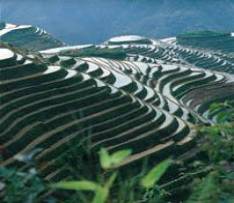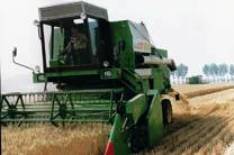|
|
|
Introduction
In 1949, China??s grain output
was 113.18 million tons, and that of cotton 444,000 tons; the agricultural
foundation was fragile. Between 1950 and 1953, the Chinese government
carried out a wide-ranging land reform in the rural areas. Peasants
with little or no land were given land of their own, greatly arousing
their enthusiasm for production. During the period of the First
Five-Year Plan (1953-57), the yearly gross output of agriculture
increased by 4.5 percent, on average. This period was the first
??golden time?? for China??s agricultural development.
From 1958 to 1978, China??s agriculture
developed slowly. During this period, China practiced the cooperative
and people??s commune systems in rural areas successively, which
emphasized the effectiveness of centralized and unified management,
but reduced the efficiency of resource utilization and allocation.
As a result, the peasants?? enthusiasm for production was greatly
dampened. In this period, the gross agricultural output value increased
by only 2.3 percent, on average, every year.
|

Terraced
fields in Longshen of Guangxi Zhuang Autonomous Region.

A
peasant driving a combine-harvester in Tengzhou, Shandong Province
|
|
??
In 1978, China introduced the
household contract responsibility system, linking remuneration to
output, and started to dismantle the people??s commune system, eliminating
the links between organizations of state power and economic organizations.
Contracting land out to peasants altered the distribution form of
land and mobilized the peasants* enthusiasm for production. In 1985,
a second reform was carried out, which eliminated the state monopoly
of purchase and marketing of agricultural products, and implemented
the system of purchase according to contracts. The reform made the
market play a basic role in adjusting the supply and demand situation
for agricultural products and allocating resources, and aroused
the peasants?? creativeness and enthusiasm for production. Commodity
production and circulation in rural areas developed at an unprecedented
scale and rate. Meanwhile, through more than ten years of adjustment,
the industrial structure in rural areas is becoming more complete
with each passing day: the proportion of primary industry has declined
markedly, while the proportion of the secondary and tertiary industries
has risen. The proportion of agriculture in primary industry has
also declined markedly, while that of animal husbandry and fisheries
has grown; the proportion of cash crops in farm production has gone
up, while that of grain crops gone down. Meanwhile, the proportion
of secondary industry has dropped, while that of tertiary industry
has risen.
For 21 years, the average growth
rate of China??s agricultural gross output value reached 6.5 percent,
the highest being 12.3 percent in 1984, which surpassed the world??s
average development level for the same period. In 1999, China??s
agricultural production continued to develop in an all-round way,
and the outputs of grain, cotton and oil-bearing crops were 508.39
million tons, 3.83 million tons and 26.012 million tons, respectively,
increases of 66.7, 76.7 and 400 percent over 1978; the output of
meat amounted to 59.61 million tons, or seven times that of 1978;
and that of aquatic products 41.224 million tons, an increase of
8.8 times over 1978. As a result, the chronic shortage of major
agricultural products was finally overcome. Now the annual average
quantities of meat, eggs and milk per person are 50, 17 and 6.6
kg, which are close to or surpass the world??s average. The problem
of shortages of food, which troubled Chinese peasants for hundreds
of years, has been solved at last.
The
rise of township enterprises has promoted the all-round development
of the agricultural economy. In 1987, the gross output value of township
enterprises exceeded that of farming; in 1990, the township enterprises
earned 13 billion US dollars from exports, about 23.8 percent of the
national gross value of foreign exchange earned from exports. Thousands
of towns are playing an important role in eliminating the differences
between urban and rural areas, and promoting the integration of urban
and rural areas. The per capita net income of peasants increased from
134 yuan in 1978 to 2,210 yuan in 1999 |
Increases in Output of Major Agricultural Products
(10,000
tons)
|
|
Variety
|
1949
|
1978
|
1999
|
|
grain
|
11,318
|
30,477
|
50,839
|
|
cotton
|
44.4
|
216.7
|
383.1
|
|
oil-bearing crops
|
256.4
|
521.8
|
2,601.2
|
|
sugarcane
|
264.2
|
2,111.6
|
7,470
|
|
sugarbeet
|
19.1
|
270.2
|
864
|
|
flue-cured tobacco
|
4.3
|
105.2
|
218.5
|
|
tea
|
4.1
|
26.8
|
67.6
|
|
fruit
|
120.0
|
657.0
|
6,237.6
|
|
meat
|
220.0
|
856.3
|
5,960.9
|
|
aquatic products
|
45
|
466
|
4,122
|
|
|



